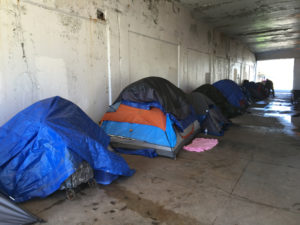By Mark Brown, columnist
One night each January, hundreds of volunteers spread out across Chicago in an effort to count the city’s homeless population.
This task, known as the annual Point-In-Time Count, is replicated in communities across the country under guidelines proscribed by the federal government.
The count is then used to apportion federal dollars for programs benefiting the homeless.
That process is deeply flawed, resulting in a significant undercount of America’s homeless population and in poorly informed public policy, according to a report issued Wednesday by the National Law Center on Homelessness & Poverty.
The national findings echo concerns often raised here by the Chicago Coalition for the Homeless — and occasionally amplified by me — regarding how the extent of homelessness in Chicago is greatly understated.
The problem is the Point-In-Time Count recognizes only homeless people who can be found that particular night, either living on the street or staying in a homeless shelter.
One obvious shortcoming: Many homeless people on the street try to avoid being seen, either out of personal safety concerns or fear they will be forced to leave their hidden place of shelter.
Less obvious is that the federal count also leaves out the much larger number of homeless families and individuals who live “doubled up” with relatives or friends because they have nowhere else to go, often creating unstable situations that are worse than being in a homeless shelter.
Last year’s Point-In-Time Count for Chicago yielded a tally of 5,657 homeless persons.
But as I reported in April, the Chicago Coalition for the Homeless analyzed U.S. Census data to better calculate the “doubled up” households and concluded that 82,212 people were homeless in Chicago at some point during 2015. The coalition is currently updating its estimate.
The report from the National Law Center on Homelessness & Poverty also notes federal guidelines fail to take into account that homelessness is often transitory, with people going in and out of homelessness, meaning that many more individuals will become homeless over the course of a year than on any given night.
The U.S. Department of Housing and Urban Development, which oversees the annual count, announced Wednesday a national homeless population of 553,742 in 2017.
That’s an increase of less than 1 percent over 2016, but the first increase since 2010, HUD officials said. Most of the increase was attributed to unsheltered homeless people living on the West Coast.
I’ve always made peace with the Point-In-Time Count on the basis that it is what it is.
There is value to a physical count, even one that is flawed. Tangible results are preferable to estimates. If you understand the annual street count is only showing you the tip of the iceberg, then you’re good to go.
Where it can go wrong is if public officials make decisions on the basis of the count, declaring homelessness to be down, when a lower count actually may have been due to other factors such as changes in the weather from one year to the next.
The city of Chicago reported that its 2017 homeless count was a 4 percent reduction from the 5,889 homeless individuals tallied in 2016. But a closer reading revealed the city used a more stringent methodology in 2017 for counting homeless people sleeping overnight on the CTA, which accounted for much of the drop. The weather was also milder on the night of the 2017 count.

A city spokesperson said Chicago complies with HUD’s requirements for the Point-In-Time Count, but “also embraces different methodologies to ensure we have the most comprehensive data on this vulnerable population.”
Those extra steps have included participating in a national research and policy initiative focused on runaway, homeless and unstably housed youth, she said.
Chicago’s 2018 homeless count is scheduled for the night of Jan. 25. Results are made public months later.
When they are released, keep in mind you’re only seeing part of the picture.
